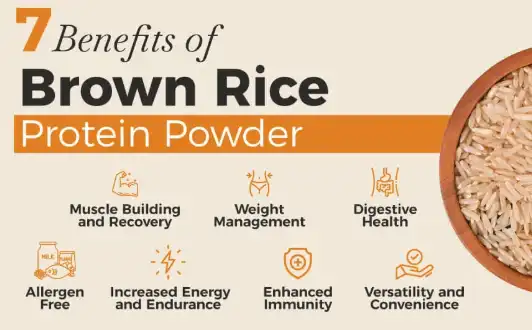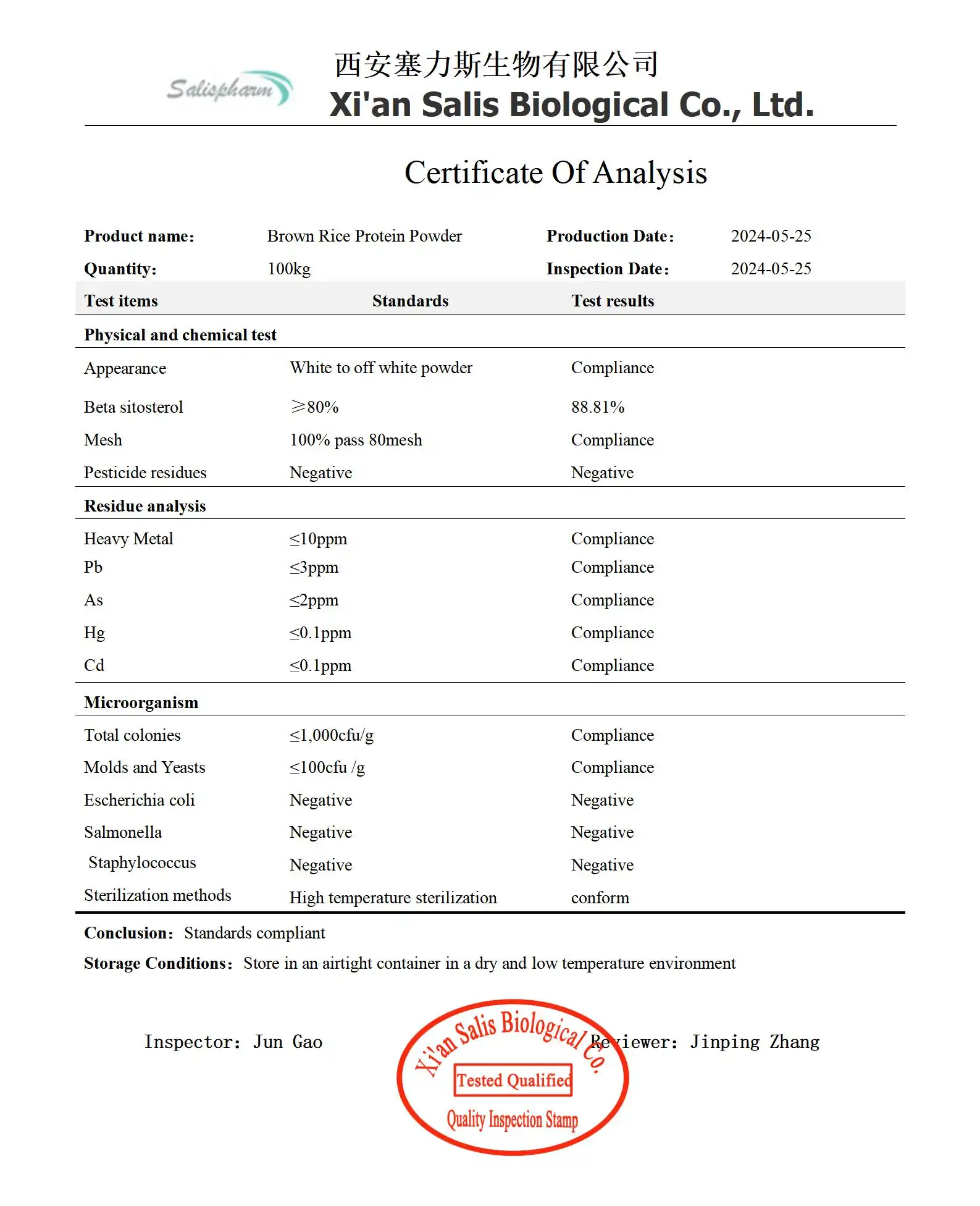Brown rice protein powder is a versatile and nutritious plant-based protein supplement that has gained popularity among health-conscious individuals, athletes, and those following vegetarian or vegan diets. This powder is derived from brown rice and offers a complete amino acid profile, making it an excellent alternative to animal-based protein sources. In this blog post, we'll explore various ways to incorporate brown rice protein powder into your daily routine and answer some common questions about its usage.

What are the benefits of brown rice protein powder?
Brown rice protein powder offers numerous benefits that make it an attractive option for those seeking to enhance their protein intake. Here are some of the key advantages:
- Complete protein source: Despite being plant-based, brown rice protein powder contains all nine essential amino acids, making it a complete protein source. This is particularly beneficial for vegetarians and vegans who may struggle to obtain all essential amino acids from their diet.
- Easily digestible: Brown rice protein is known for its high digestibility, which means your body can efficiently absorb and utilize the protein. This makes it an excellent option for those with sensitive stomachs or digestive issues.
- Hypoallergenic: Unlike some other protein sources, such as whey or soy, brown rice protein is naturally hypoallergenic. This makes it a suitable choice for individuals with food allergies or sensitivities.
- Rich in nutrients: Beyond protein, brown rice protein powder often contains other beneficial nutrients, including fiber, vitamins, and minerals. These additional nutrients contribute to overall health and well-being.
- Supports muscle growth and recovery: The amino acid profile of brown rice protein, particularly its high leucine content, supports muscle protein synthesis. This makes it an effective supplement for athletes and fitness enthusiasts looking to build and repair muscle tissue.
- Weight management: Protein is known to promote satiety, helping you feel full for longer periods. Incorporating brown rice protein powder into your diet can assist with weight management by reducing overall calorie intake.
- Versatile and easy to use: Brown rice protein powder can be easily incorporated into various recipes and beverages, making it a convenient way to boost your protein intake throughout the day.
To fully reap these benefits, it's important to understand how to properly use brown rice protein powder and incorporate it into your daily routine. Let's explore some practical ways to do so in the following sections.
How much brown rice protein powder should I take daily?
Determining the appropriate amount of brown rice protein powder to consume daily depends on various factors, including your age, gender, weight, activity level, and overall health goals. Here are some guidelines to help you determine the right dosage:
- General protein requirements: The Recommended Dietary Allowance (RDA) for protein is 0.8 grams per kilogram of body weight for sedentary adults. However, this is considered the minimum amount to prevent deficiency, and many people benefit from higher protein intake.
- Active individuals and athletes: Those engaged in regular exercise or intense physical activities may require 1.2 to 2.0 grams of protein per kilogram of body weight. This increased intake helps support muscle recovery and growth.
- Weight loss goals: If you're aiming to lose weight, a higher protein intake of 1.6 to 2.2 grams per kilogram of body weight can be beneficial. Protein helps preserve lean muscle mass during calorie restriction and promotes satiety.
- Muscle building: For individuals looking to build muscle, a protein intake of 1.6 to 2.2 grams per kilogram of body weight is often recommended to support muscle protein synthesis.
To calculate your specific protein needs, multiply your weight in kilograms by the appropriate factor based on your goals and activity level. For example, a 70 kg (154 lbs) moderately active individual aiming for general health might aim for about 84-112 grams of protein per day (70 kg x 1.2-1.6 g/kg).
Once you've determined your total daily protein needs, you can decide how much of that should come from brown rice protein powder. It's generally recommended to obtain most of your protein from whole food sources and use protein powder as a supplement to fill any gaps in your diet.
A typical serving of brown rice protein powder contains about 20-25 grams of protein. Depending on your needs, you might consume one to three servings per day. Here are some scenarios:
- Post-workout supplement: Consume one serving (20-25g) of brown rice protein powder within 30 minutes after your workout to support muscle recovery.
- Meal replacement: Use one serving of brown rice protein powder blended with fruits, vegetables, and healthy fats as a meal replacement when you're short on time.
- Snack: Have half a serving (10-12g) of brown rice protein powder mixed with water or plant-based milk as a quick, protein-rich snack between meals.
Remember, it's essential to listen to your body and adjust your intake based on how you feel and your progress towards your health goals. If you're unsure about the right amount for you, consult with a registered dietitian or healthcare professional who can provide personalized recommendations based on your individual needs and health status.
Can I mix brown rice protein powder with water?
Yes, you can absolutely mix brown rice protein powder with water. In fact, this is one of the simplest and most straightforward ways to consume this supplement. However, there are several factors to consider when mixing brown rice protein powder with water, as well as alternative mixing options that might enhance your experience:
Mixing with Water:
- Simplicity: Mixing brown rice protein powder with water is quick, easy, and requires no additional ingredients. This makes it an ideal option for post-workout recovery or when you're on the go.
- Calorie control: If you're watching your calorie intake, mixing the powder with water adds no extra calories to your protein shake.
- Taste and texture: Brown rice protein powder mixed with water may have a slightly grainy texture and a mild, nutty flavor. Some people enjoy this, while others might find it less palatable compared to other mixing options.
- Mixing technique: To achieve a smoother consistency, use a shaker bottle or blend the mixture in a blender. Start with a small amount of water, add the powder, and then gradually add more water while mixing to reach your desired consistency.
Alternative Mixing Options:
While water is a perfectly acceptable mixing option, you might want to explore other liquids or ingredients to enhance the taste, texture, and nutritional profile of your protein shake:
- Plant-based milk: Mixing brown rice protein powder with almond milk, oat milk, or coconut milk can improve the taste and create a creamier texture. These options also add some additional nutrients and healthy fats.
- Fruit juice: For a sweeter taste, try mixing the powder with 100% fruit juice. This can mask the flavor of the protein powder and provide additional vitamins and antioxidants. However, be mindful of the added sugar content in juices.
- Smoothies: Incorporate brown rice protein powder into a smoothie with fruits, vegetables, and other nutritious ingredients. This not only improves the taste but also increases the overall nutritional value of your shake.
- Coffee or tea: For a protein-packed morning boost, try mixing brown rice protein powder into your coffee or tea. This works particularly well with flavored protein powders like vanilla or chocolate.
- Oatmeal or yogurt: Stir brown rice protein powder into your morning oatmeal or yogurt for an easy protein boost. This can help keep you feeling full and satisfied throughout the morning.
Tips for Better Mixing:
- Use cold or room temperature liquids: Brown rice protein powder tends to mix better with cold or room temperature liquids rather than hot ones.
- Add powder to liquid: To prevent clumping, add the protein powder to the liquid rather than the other way around.
- Use a blender or shaker bottle: These tools help break up clumps and create a smoother consistency.
- Let it sit: If you notice any clumps, let the mixture sit for a few minutes and then shake or stir again.
- Adjust the ratio: Experiment with the powder-to-liquid ratio to find your preferred consistency. Some people prefer a thicker shake, while others like it more diluted.
Remember that the best way to consume brown rice protein powder is the way that you enjoy most and can consistently incorporate into your routine. Don't be afraid to experiment with different mixing methods and recipes to find what works best for you. Whether you prefer a simple water mix or a more elaborate smoothie, the key is to make it a sustainable part of your nutrition plan.
Conclusion
Brown rice protein powder is a versatile and nutritious supplement that can be easily incorporated into your daily routine. Whether you're looking to increase your protein intake, support muscle growth and recovery, or simply add a nutritious boost to your diet, brown rice protein powder offers a plant-based solution suitable for various dietary needs and preferences. By understanding the benefits, appropriate dosage, and mixing options, you can make the most of this supplement and support your overall health and fitness goals.
If you are also interested in this product and want to know more product details, or want to know about other related products, please feel free to contact lea_slsbio@163.com,WhatsApp+86 13193326505.

References
1. Joy, J. M., et al. (2013). The effects of 8 weeks of whey or rice protein supplementation on body composition and exercise performance. Nutrition Journal, 12(1), 86.
2. Kalman, D. S. (2014). Amino Acid Composition of an Organic Brown Rice Protein Concentrate and Isolate Compared to Soy and Whey Concentrates and Isolates. Foods, 3(3), 394-402.
3. van Vliet, S., Burd, N. A., & van Loon, L. J. (2015). The Skeletal Muscle Anabolic Response to Plant- versus Animal-Based Protein Consumption. The Journal of Nutrition, 145(9), 1981-1991.
4. Babault, N., et al. (2015). Pea proteins oral supplementation promotes muscle thickness gains during resistance training: a double-blind, randomized, Placebo-controlled clinical trial vs. Whey protein. Journal of the International Society of Sports Nutrition, 12(1), 3.
5. Gorissen, S. H., et al. (2018). Protein content and amino acid composition of commercially available plant-based protein isolates. Amino Acids, 50(12), 1685-1695.
6. Leser, S. (2013). The 2013 FAO report on dietary protein quality evaluation in human nutrition: Recommendations and implications. Nutrition Bulletin, 38(4), 421-428.

